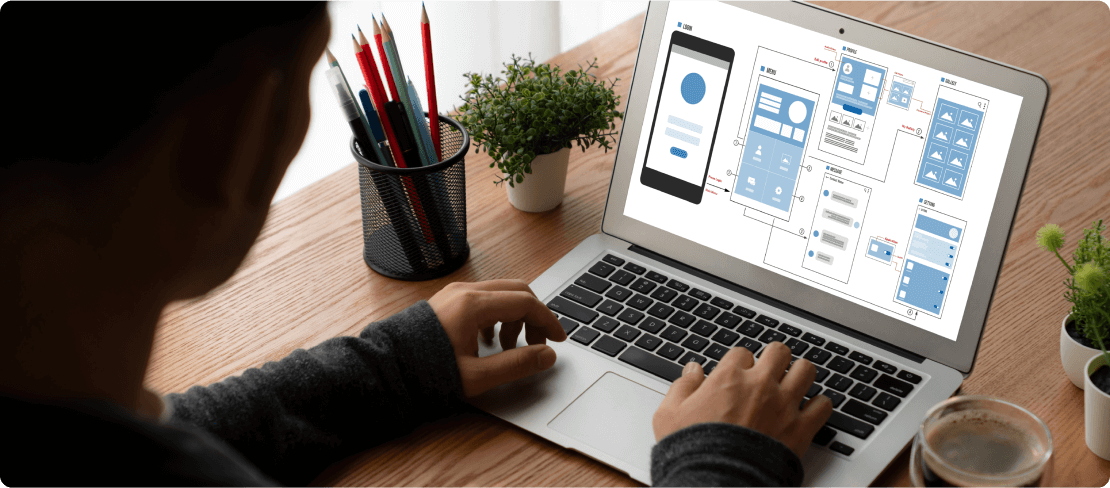
Introduction
Digital Product Design is an ever-evolving process indispensable in crafting exceptional intuitive and interactive user interfaces and user experience in mobile applications. The crucial components of digital product design identify user preferences and requirements to create innovative interfaces that captivate users and provide seamless experiences. One of the significant reasons for choosing digital product design services is to build a mobile app that integrates with modern digital transformation technologies and stands apart in the competitive landscape.
Actors
01
UI/UX Designer
They create beautiful and relevant UI/UX designs for mobile applications using their experiences.
02
Mobile App Developers
Mobile app developers implement UI/UX designs into the mobile app to make it functional with thorough testing and quality assurance.
03
Mobile App Development Company
Clients/customers contact a mobile app development company to build UI/UX mobile apps that resonate with their brand image.
04
Clients
They are mobile app owners who approve the design or share ideas about their app to commence the project.
05
End Customer/User
Individuals who download and install the app to use it.
Preconditions
Requirement Gathering
Any UI/UX design project commences with generating an app idea, defining the purpose of building the app, and collecting information about its features and functionalities. It helps provide a clear understanding of creating UI/UX designs that align with the client’s goals.
Comprehensive Research
Digital product design and development involves extensive research to define the target audience, their specific needs, preferences, and behaviors, and identify the major pain points. It allows designers to enhance user experience.
Understanding the Brand Image
The designers develop a deep understanding of the brand that helps them craft UI/UX for mobile apps that resonate with the company’s brand. Complying with brand identity lets them design outstanding app logos and use the best color palettes, typography, and fonts, bringing consistency throughout the app.
Post Conditions
User-Centric Designs
The product or UI/UX design concentrates on crafting user-centric designs that reflect user preferences and requirements. This leads to improved user engagement, satisfaction, and retention.
The Finalized UI/UX Designs
The UI/UX design gets a green and final go-ahead signal from the client to be implemented into the app by the developers. This is an essential transition step from design to development where stakeholders remain in the loop with the app’s progress.
Enhanced User Engagement
A well-designed mobile app with rich UI/UX can amplify better user engagement and enhance their experiences. Users find it easier to navigate the app, driving more retention, higher satisfaction levels, and positive reviews and ratings. It reduces application churn rates.
Increased App Revenue
Once the level of engagement and satisfaction increases and customers find it more appealing, the chances of generating more revenue are enhanced. This creates opportunities for app monetization.
Gaining Competitive Advantage
An intuitively designed mobile app gains the upper hand in the competitive landscape as it offers something unique to stand apart from the crowd. Users can easily distinguish that app from others, transforming it into a brand and building trust.
Future-Proofing
Technology and the mobile app's UI/UX keep evolving. The designer remains focused on exceeding user expectations to make the app more scalable and agile.
Main Flow
Alternative Flow
- Flaws During the Testing - If the quality assurance specialist comes across any issues while user testing, the designer has to iterate the design to improve the user interactions, visual elements, and layouts, addressing all the flaws.
- Technical Constraints - If developers detect any pitfall in the application design, they must report it to the designers, who will rectify the error to bring consistency and augment user experience.

Conclusion
Implementing digital product design services to carve out a captivating and eye-pleasing UI/UX design for mobile apps involves a structured workflow with strategic planning, extensive analysis, and research. The final goal is to provide a seamless navigation experience to end users and enhance user engagement and retention through robust collaboration between all stakeholders.
Suggested TechStack
Sketch is an UI design tool that simplifies the process by allowing the installation of plugins and enabling wireframing with ease, in addition to providing feature-rich UI functionalities.

Today, Figma has become the first preference of several UI/UX designers due to its fast and easy design process, streamlining collaboration. It offers a rich library of project components and allows control of all app versions.

A newly introduced UI/UX framework launched in 2019 makes iOS app designing much easier and more efficient. However, this framework is only compatible with the iOS 13.0 version or higher and offers limited resources to designers.

It is Apple’s basic framework for creating graphical components and user interfaces in the iOS application. It offers templates that define user interface elements to frame the app blocks.

Enhancing Mobile App User Experiences Through Digital Product Designs That Captivate Customers
Beautifully Crafted Mobile UI/UX With Digital Product Design

